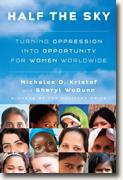Half the Sky
Nicholas D. Kristof and Sheryl WuDunn
book reviews:
· general fiction
· chick lit/romance
· sci-fi/fantasy
· graphic novels
· nonfiction
· audio books
· author interviews
· children's books @
curledupkids.com
· DVD reviews @
curledupdvd.com
newsletter
win books
buy online
links
home
for authors
& publishers
for reviewers

 |
Half the Sky: Turning Oppression into Opportunity for Women Worldwide Nicholas D. Kristof and Sheryl WuDunn Knopf Hardcover 320 pages September 2009 |
|
One does not have to be an academic researcher or a social activist to recognize that in contemporary times, the systematic oppression of women and the violence that affects the lives of so many women are major public policy problems that need to be confronted head on. Unfortunately, despite the salience of the underlying problems, it is fair to say that the response of the international community thus far to these and other related problems has been underwhelming. Given this saturnine state of affairs, in this book, the Pulitzer Prize-winning journalist duo of Nicholas Kristof and Sheryl WuDunn issue an admirable and noteworthy call to arms against the subjugation of women and girls in the developing countries of the world.
Next, consider rape. This despicable act is very prevalent in many of the world’s poor countries. Two key features of rape are essential to grasp well. First, “the problem is not so much individual thugs and rapists but an entire culture of sexual predation” (p. 62). For instance, Ethiopian law explicitly disallows the prosecution of a man who has violated a woman as long as he subsequently marries her. Second, rape has been and continues to be used as a systematic weapon with which certain ethnic groups are terrorized. Rape has become an effective tool of war “in conservative societies precisely because female sexuality is so sacred” (p. 83). The authors support the idea that to deal with rape, especially rape used as an instrument of terror in civil wars, the United Nations (UN) Secretary General Ban Ki-Moon ought to make “mass rape a priority and pledge to resign if member countries don’t support him” (p. 86). Finally, consider education. The authors repeatedly make the altogether valid point that education, particularly female education, is the single best antidote to all manner of ills that currently plague girls and women throughout the developing world. For instance, if one is interested in reducing the size of families, then birth control mechanisms are clearly needed - but “the most effective contraceptive is education for girls...” (p. 135). Similarly, the authors contend that the provision of education is one of the best ways to combat poverty and eventually the desire to use violent means to obtain one’s desired goals in society. The book chronicles an interesting case in which the active grassroots support for female education by a Welsh woman named Ann Cotton in rural Zimbabwe has accomplished a great deal. As the authors tellingly point out, these “kinds of grassroots efforts usually achieve more than the grand UN conferences that receive far more attention” (p. 182). This book does suffer from a few errors of commission and omission. In particular, the book pays insufficient attention to the nexus between water use and female roles in many developing countries. The book also concentrates on too many individual cases; on occasion, it reads more like a travelogue and less like a book with reasoned analysis. These caveats notwithstanding, Half the Sky Originally published on Curled Up With A Good Book at www.curledup.com. © Amitrajeet A. Batabyal, 2010 |
|
|
|
 Click here to learn more about this month's sponsor! |
|
| fiction · sf/f · comic books · nonfiction · audio newsletter · free book contest · buy books online review index · links · · authors & publishers reviewers |
|
| site by ELBO Computing Resources, Inc. | |
 First, consider prostitution. We are told that there are disproportionately large numbers of prostitutes in India, Pakistan, and Iran, countries “with the most straitlaced and sexually conservative societies...” (p. 6). According to the authors, a key reason is that young men in these nations typically do not sleep with their girlfriends. Therefore, it has become standard for them to relieve their sexual frustrations with prostitutes. The authors go on to credibly argue that even though we generally do not think of prostitutes as slaves, millions of women and girls are, in fact, enslaved, and therefore it is appropriate to view sex trafficking and slavery as equivalent activities. Three lessons emerge from this focus on prostitution. First, rescuing girls from brothels is both complicated and uncertain. Second, even in difficult circumstances, one should never give up hope as far as helping people get out of prostitution is concerned. Finally, “even when a social problem is so vast as to be insoluble in its entirety, it’s still worth mitigating” (p. 45).
First, consider prostitution. We are told that there are disproportionately large numbers of prostitutes in India, Pakistan, and Iran, countries “with the most straitlaced and sexually conservative societies...” (p. 6). According to the authors, a key reason is that young men in these nations typically do not sleep with their girlfriends. Therefore, it has become standard for them to relieve their sexual frustrations with prostitutes. The authors go on to credibly argue that even though we generally do not think of prostitutes as slaves, millions of women and girls are, in fact, enslaved, and therefore it is appropriate to view sex trafficking and slavery as equivalent activities. Three lessons emerge from this focus on prostitution. First, rescuing girls from brothels is both complicated and uncertain. Second, even in difficult circumstances, one should never give up hope as far as helping people get out of prostitution is concerned. Finally, “even when a social problem is so vast as to be insoluble in its entirety, it’s still worth mitigating” (p. 45).